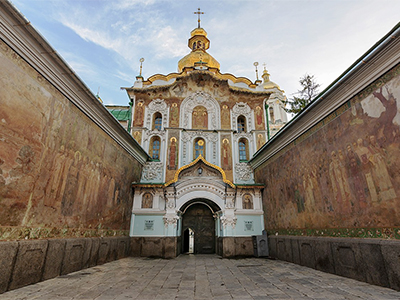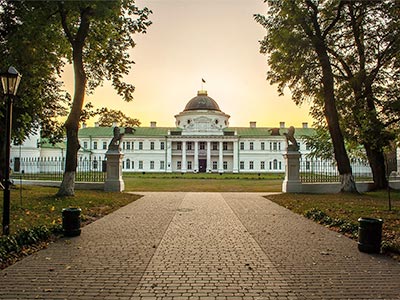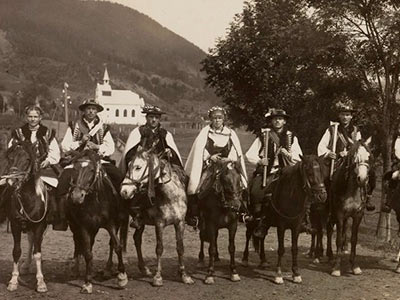 29.01.2024
Exploring the Treasures of Kyiv’s Lavra Monastery
29.01.2024
Exploring the Treasures of Kyiv’s Lavra MonasteryEvery ancient town has some distinctly unique features that make it different from any other town and easily recognizable. In this respect such towns are like human faces marked with profound personalities. An ancient town’s history can be traced through its ancient buildings, gates and walls if they are still standing. The city of Kyiv happens to be a place of venerable age: whose history spans about fifteen hundred years, arid it is but natural that it can boast a number of ancient buildings, though not so many as one would wish — the ravages of war and implacable time have taken their very heavy toll. It is quite impossible to imagine Kyiv without Holy Sophia Cathedral, St. Andrew’s Church, the Golden Gate and, of course, the Kyiv Pechersk. Lavra Monastery is a place of special attraction both to the layman and historian alike.
Lavra Monastery
The Pechersk Lavra Monastery (Pechersk stands for pechery, that is “caves” which are to be found in its territory and which early monks used to live in, and Lavra an honorific title given to a monastery of extra-size and religious importance) came into being in the eleventh century and for nine centuries its territory was expanding with new buildings being added to it through the centuries. The architectural complex of the Monastery the way it looks today is truly grandiose. On a sunny day one is almost dazzled by the reflections from the innumerable golden domes above churches mid belfries. Most of the buildings in the Monastery date from the seventeenth and eighteenth centuries and are excellent examples of Ukrainian Baroque style in architecture and there is only one church in the Monastery that has been preserved from the twelfth century with very few architectural changes introduced since then. The church sits above the main entrance gate of the Monastery and is consequently called Nadvratna — “the one above the gate”. The full name of the church is Troitska Nadbramna Tserkva – “The Holy Trinity Church above the Gate”. It is almost a miracle it has survived as the Monastery itself was throughout its history the object of so many enemy attacks, of devastating fires and of other crippling misfortunes.
12th century construction
It was. built in 1106-1108 as a defensive tower above the main entrance gate of the Monastery. The church proper was on the second floor, right above the gate. The heavy pillars divide the interior of the church into three naves, each of them with a rounded apse at the eastern side (the apses are seen only from the inside — the exterior wall is flat). Built-in hollow spaces in the walls made the acoustics better and the whole structure lighter. Several narrow windows, piercing the walls, and the general visual upward movement of its architectural shapes create a feeling of uplifting lightness. The church in its design bears a clear imprint of the typical church construction of the eleventh-twelfth centuries widely spread throughout. Kyivan Rus-Ukraine. At the end of the seventeenth and in the course of the eighteenth centuries it went through a considerable renovation after which it acquired its Ukrainian Baroque look. The changes introduced a new pear-shaped dome, new decorations and new wall paintings. The original ascetic look was superseded by Baroque playfulness.
18th century fresces
In the 1730s-1740s a group of painters from the Monastery’s icon school of painting decorated the church with frescoes in tempera and oil. The subjects for all of the wall-paintings were taken from the Bible but ornamentation and color arrangement were definitely influenced by the Ukrainian folk art traditions. The painters’ names had remained unknown for a long time and it was only recently that study of the archives revealed them.
Among the frescoes four merit a special attention because of their high artistic quality: Saints Marching into Paradise at the entrance way, the Nicene Council on the western wall; Expulsion of the Merchants from the Temple above the entrance and Baptism of an Ethiopian by Apostle Philip on the northern wall.
Through the entrance way one walks into the church and since all parts of the church have some symbolic meaning the entrance way is not an exception – it symbolizes the road that takes one to God. The fresco on the wall depicts the march of the Righteous into Paradise. They are led by the flying and trumpeting angels who are encouraged to do so by God the father depicted on the ceiling. Paradise is shown as an imaginative landscape through which peacocks, elephants, camels and other exotic animals roam freely.
The fresco in the central apse of the church is devoted to the First Council of Nicaea (AD 325) which established the Nicene Creed and opposed Arianism. In the very center of the composition made up of many figures one can see Emperor Constantine surrounded by church hierarchy. The painters didn’t care to grab all the personages in appropriate historical clothes but painted them dressed in the costumes of the eighteenth century instead. On the left- hand side one can see Hetman Ivan Skoropadsky depicted in the fresco.
Expulsion of the Merchants from the Temple above the entrance has a highly dynamic composition with the merchants, being expelled by Jesus Christ, running towards the real door in the wall.
Iconostasis
Iconostasis is the partition with doors, adorned with icons, which separates the beam of a church from the central nave. The iconostasis of the Trinity Church above the Gate was carved out of lime-tree wood in 1734 and gilded. The gilt in combination with ornate ornamentation creates a festive mood in the church. The icons were painted in the style that reflects the style of the frescoes, and follow the lines set by the Monastery: the faces of the holy personages and saints must show profound wisdom, heavenly inspiration and unearthly serenity.
Virgin with Child, one of the central icons in importance and place, is full of poetic tenderness and happy love of mother for her child. The Archangels, the Holy Trinity and the Savior are to be seen on other icons, executed in the same (sure hand. A big sixteen-candle chandelier, cast in 1725, is a valuable addition to the harmonious arrangement of the interior. When you enter the church, you feel as though you have come home – so cozy it is. The church seems to be an artistic and spiritual link between the past and the present.
-
 27.02.2024
World of pysanka
Embark on a journey into the captivating world of Pysanka, the Ukrainian...
27.02.2024
World of pysanka
Embark on a journey into the captivating world of Pysanka, the Ukrainian...
-
 13.01.2024
Kachanivka, Eden on Earth
Rich in history, it hosted renowned artists, notably poet Taras Shevchenko.
13.01.2024
Kachanivka, Eden on Earth
Rich in history, it hosted renowned artists, notably poet Taras Shevchenko.
-
 05.01.2024
Hutsuls: passionate and Freedom-Loving
Hutsul men used to carry weapons with them, pistols and axes on...
05.01.2024
Hutsuls: passionate and Freedom-Loving
Hutsul men used to carry weapons with them, pistols and axes on...

